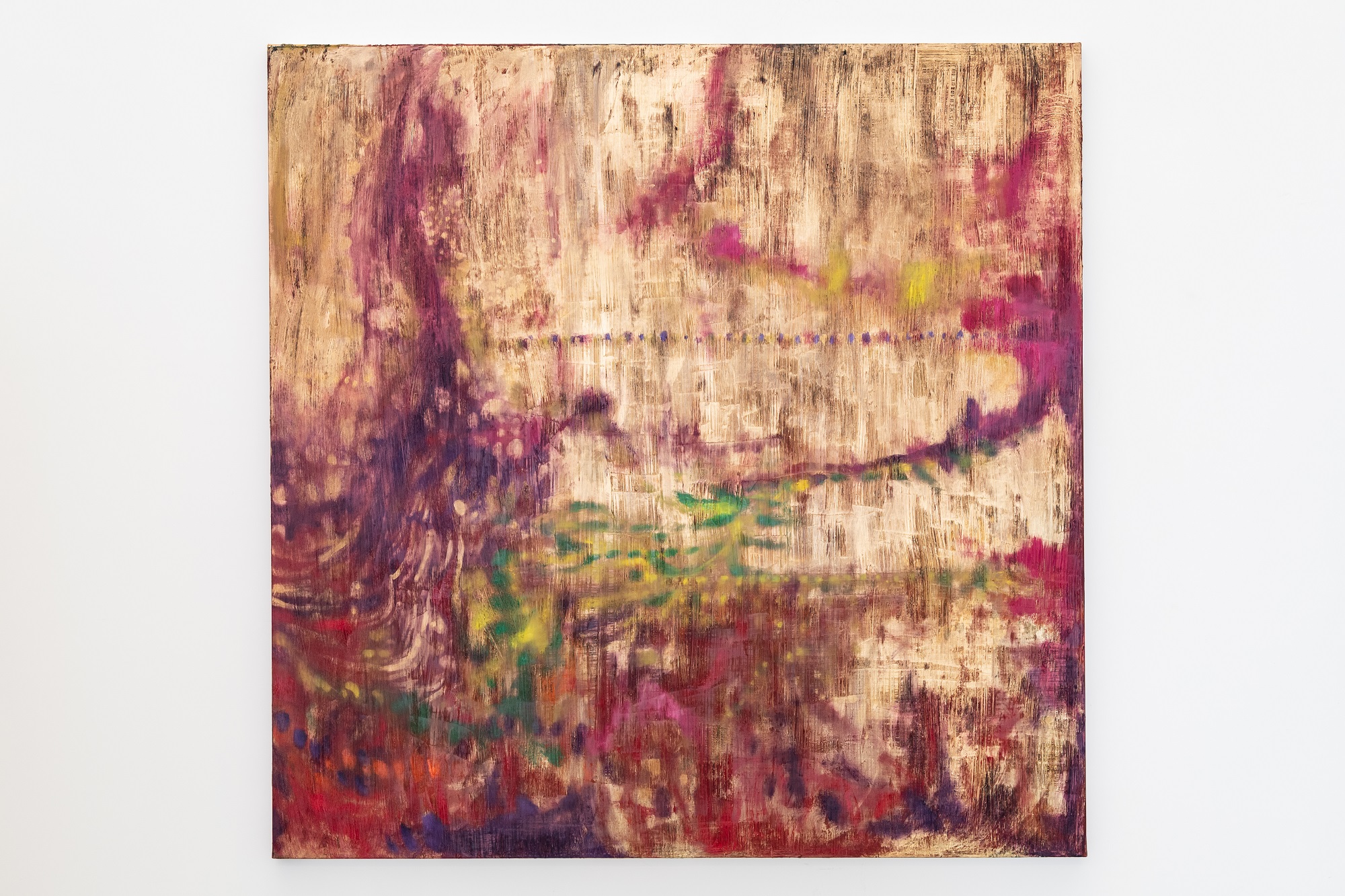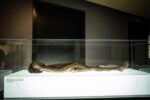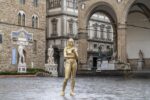Marco Cingolani – Revenge Gold

Seconda personale dell’artista Marco Cingolani, intitolata “Revenge Gold”. In mostra sarà esposta una serie di opere in grande formato dell’artista.
Comunicato stampa
La galleria Thomas Brambilla è lieta di presentare la seconda personale dell’artista Marco Cingolani, intitolata “Revenge Gold”. In mostra sarà esposta una serie di opere in grande formato dell’artista e inaugurerà venerdì 13 gennaio alle ore 18.
“Revenge Gold” è un titolo che non vuole passare inosservato. Sono parole lapidarie che alludono alla potenza, alla seduzione e alla maledizione dell’oro. Ma sembrano anche ricordare “L’Estasi dell’Oro”, ovvero il titolo di un brano di Ennio Morricone che, per altro, conclude “Il Buono, Il Brutto e il Cattivo” di Sergio Leone. Alla fine della pellicola, si sente una potente orchestra che sottolinea il duello nel piccolo cimitero dove un bandito aveva seppellito una bara vuota piena di monete d’oro sonanti.
Forse il titolo “Revenge Gold” vuole anche sottolineare il baratro inflazionistico della moneta odierna priva di ogni sottostante aurifero? Oppure vuole, forse, ribadire che il valore dell’oro non è solo economico, ma è soprattutto spirituale, evocando pratiche di trasformazione alchemica dei propri difetti ed eliminando scorie ed impurità?
Materiale e spirituale è una dicotomia spesso insanabile, che però, è stata resa armoniosa nei millenni dall’oro: regalità, ricchezza, dono ed elevazione, ma anche corruzione e violenza.
Comunque il lato oscuro del “Revenge Gold” è evidente nell’assonanza con “Revenge Porn”, pratica scorretta ed illegale che ben illustra il malcostume del “possesso” privo di etica: l’oro racchiude in sé l’amore e i pettegolezzi, gli slanci e le maldicenze.
La pratica artistica di Cingolani, difatti, ha sempre oscillato tra la materialità del racconto, epico o grottesco che sia, e la ricerca di stasi e contemplazione. Già dagli anni Ottanta, Cingolani creò una serie di lavori dedicati a Wall Street e alla potenza economica derivata dall’accumulo di denaro e alla sua caducità stessa. Successivamente, iniziò a lavorare alla famosa serie intitolata “Interviste”, ovvero opere ispirate ad avvenimenti storici carichi di simbolicità, fino alla recente dedicata al “Pathos Formel”, nella quale un racconto, seppur misterioso, riesce a sopravvivere.
In questa nuova serie in mostra, invece, non c’è traccia di società, di comunicazione mediatica, nessuna metafora né pareidolia, bensì semplicemente la scabrosità di una superficie quasi interamente dorata che ospita una fitta trama di sovrapposizioni, permettendo l’affioramento di segni, macchie, punti, ombre, brandelli, schiacciamenti. Lo spazio della tela diventa il luogo della trasformazione della materia, un crogiolo fisico nel quale il corpo dell’artista, diviene il tramite della celebrazione dell’atto artistico, un’alchimia senza scopo e senza giustificazione sociale, se non la creazione dell’arte stessa. Il pittore si è qui prolungato nei suoi strumenti; oltre a pennelli e colori, spazzole di ferro, forchette, stracci assorbenti, coltelli seghettati usati per sovrapporre e sottrarre, fino a quando l’opera si impone nella sua chiarezza e luminosità.
L’oro -the Revenge Gold- sottopone tutti i personaggi ed i segni tipici di Cingolani a una sorta di purificazione, come nel crogiolo alchemico dove le continue sovrapposizioni eliminano ogni esercizio abituale, annullando la “dannazione mediterranea” di voler compiacere lo spettatore raccontandogli una storia: sul proprio compiacimento, il pittore, stende una mano di oro e ricomincia da capo con l’entusiasmo e l’emozione della prima volta.
Marco Cingolani nasce a Como nel 1961 e si trasferisce a Milano giovanissimo, nel 1978. Inizia a frequentare l’ambiente creativo underground, in cui l’arte si mischiava con la moda e la musica punk. In quegli anni si stava formalizzando a Milano una nuova sensibilità artistica le cui radici non affondavano più nella storia dell’arte e nella citazione ma praticava la manipolazione critica della realtà e della sua comunicazione attraverso i mass media.
È definito il maestro del colore; quest’ultimo, infatti, diviene il protagonista delle tele e si tramuta in una serie di sovrapposizioni, sfumature, graffi e trasparenze accanto a zone timbriche, aggiungendo toni e sfocature. L’immagine veniva decontestualizzata, sottratta all’uso del senso comune, stravolta radicalmente, quasi schernita. Il lavoro di Marco Cingolani, sin dagli esordi, ha sempre cercato di annullare il potere normativo delle immagini mediatiche, sottoponendole alla cura radicale dell’artista, certo che l’arte offra un punto di vista decisivo per l’interpretazione del mondo. Da qui nacquero, la serie di grandi dipinti denominata Le Interviste - in cui i protagonisti sono oppressi dai microfoni dei giornalisti -, la famosa serie dedicata all'attentato alla vita di Papa Giovanni Paolo II ed il tragico assassinio di Aldo Moro. Questo forte legame con la realtà è espresso nelle sue opere dalla contestualizzazione simbolica di diversi elementi, come i caschi blu del Consiglio di sicurezza delle Nazioni Unite, segmenti multicolori dei grafici di Wall Street, uniformi militari e bandiere dei partiti politici.
Cingolani ha esposto in diverse gallerie e istituzioni museali; tra le principali mostre personali e collettive: Galleria Emilio Mazzoli, Modena, Italy; Galleria Continua, S. Gimignano, Italy; S.M.A.K. di Gent, Belgio; Museo Pecci, Prato, Italy; al Museo Nazionale di Villa Guinigi, Lucca; Palazzo Strozzi, Firenze; Galleria Nazionale d’Arte Moderna, Roma, Italy; 53esima Biennale di Venezia, Italy; PAC, Padiglione d’arte contemporanea, Milano, Italy.
Marco Cingolani – Revenge Gold
13/01/2023 – 01/03/2023
Opening: Friday 13 January 2023.
Opening hours: Monday-Fridat h 14-19.
Thomas Brambilla Gallery proudly presents Marco Cingolani’s second solo show, “Revenge Gold”. The exhibition opens on Friday, January 13th at 6 PM and includes a series of large-format paintings.
The title, “Revenge Gold”, doesn’t want to pass unnoticed. These lapidary words allude to gold’s power, seduction, and curse. Yet, they also remind us of Ennio Morricone’s song, “The Ecstasy of Gold”, closing Sergio Leone’s “The Good, The Bad, and The Ugly”. At the movie’s end, the audience hears a powerful orchestra accompanying a duel set in a small cemetery, where a bandit buried a coffin filled with shimmering gold coins.
Does the title “Revenge Gold” intend to underline the inflationary abyss of today’s money, devoid of any golden substrate, too? Or maybe to reiterate that gold’s value is not just economical but essentially spiritual, evoking alchemic transformation practices to eliminate its defects and impurities? Of course, material and spiritual is an often-irreconcilable dichotomy, yet gold has made it harmonious for millennia: royalty, wealth, gift, and elevation, but also corruption and violence.
However, “Revenge Gold”’s dark side becomes evident in its assonance with “Revenge Porn”, an unfair and illegal practice that clearly illustrates the unethical malpractice of “possession”: gold encapsulates the love and the gossip, the outbursts and the slanders.
Indeed, Cingolani’s artistic practice has always oscillated between a tale’s materiality (either epic or grotesque) and the search for stasis and contemplation. During the Eighties, Cingolani created a series of artworks dedicated to Wall Street, the economic power derived from the accumulation of money and its own caducity. After that, he started working on the famous series titled “Interviste” (“Interviews”), artworks inspired by historical events loaded with symbolism. Then, he focused on a recent series dedicated to “Pathos Formel”, in which a tale, no matter how mysterious, manages to survive.
On the contrary, in the newly exhibited series, there is no trace of society, mediatic communication, metaphors, or pareidolia. Instead, we see the simple roughness of an almost entirely golden surface, hosting a compact texture of layers and allowing marks, spots, specks, shadows, shreds, and crushings to emerge. The canvas becomes the space for the matter’s transformation, a physical melting pot in which the artist’s body becomes a means to celebrate the artistic practice, a social ritual of alchemy, aimless and unjustified if not for the creation of art itself. Here, the painter has prolonged himself through his instruments, beyond the brushes and the colors, the iron brushes, forks, absorbent towels, and the serrated knives used to layer and remove matter until the artwork presents itself in all its clarity and brightness. The gold - the Revenge Gold - prompts all of Cingolani’s typical characters and symbols to undergo a sort of cleansing in an alchemic melting pot, where the continuous overlays eliminate any regular practice. This way, it nullifies that “Mediterranean damnation” of wanting to appease the viewer by telling them a story: the painter spreads a hand of gold on his own satisfaction and starts over with the enthusiasm and the emotion of the first time.
Marco Cingolani was born in Como in 1961 and moved to Milan at a very young age, in 1978. He began to frequent the underground creative environment, where art mixed with fashion and punk music. In those years a new artistic sensibility was being formalized in Milan whose roots no longer sank in the history of art and in quotation but practiced the critical manipulation of reality and its communication through the mass media.
Cingolani is known as the “master of color”. In his works, color often becomes a continuous series of overlaps, nuances and scratches, transparencies next to timbre zones, color that covers other color, adding tones and blurs. His work has always focused on the possibility to erase the normative power of media imagery, subjecting it to the radical “cure” of the Artist, being certain that Art provides a decisive point of view to read the world. The Artist has always been fascinated by the transition from “pieces of news” to History and back, and in fact it was in this context that more than one series of artworks was born. Here we mention: the series of great oil paintings called Le Interviste (The Interviews) - in which the protagonists are oppressed by the journalists’ microphones -, the famous series dedicated to the attempt on Pope John Paul II’s life, and the tragic murder of Aldo Moro. This strong link to reality is expressed in his works by the symbolical contextualization of several elements, such as UN Security Council blue helmets, multi-coloured segments of Wall Street graphs, military uniforms, and political parties’ flags.
Cingolani has exhibited in various galleries, museums and institutions, among them: Galleria Emilio Mazzoli, Modena, Italy; Galleria Continua, San Gimignano, Italy; S.M.A.K. of Ghent, Belgium; Pecci Museum, Prato, Italy; at the National Museum of Villa Guinigi, Lucca; Palazzo Strozzi, Florence; National Gallery of Modern Art, Rome, Italy; 53rd Venice Biennale, Italy; PAC, Contemporary Art Pavilion, Milan, Italy.



